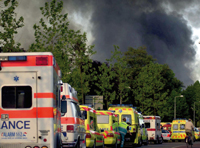|
TETRA – Terrestrial Trunked Radio – is a digital trunked mobile radio standard developed by the European Telecommunications Standards Institute (ETSI). The standard was designed to meet the needs of professional mobile radio (PMR) user organizations – essentially, people who work in groups. When TETRA was created in the early 1990s, we were working in the analogue world, and TETRA was marked as the first digital trunked technology for group use. TETRA has now spread to, at the last count (in September 2010), 114 countries. Its secure, reliable and proven performance is trusted by industries and organizations worldwide, including public safety and security services, air, rail and water transport, public utilities, the oil and gas exploration, extraction and delivery industries, international and global sporting events, car manufacturing plants and casinos – networks of all sizes, from a single site to 3500. InteroperabilityTETRA’s success is built on the robust network performance and secure communications services that the technology delivers. The strength and depth of this success is underpinned by the interoperability of the technology. This means is that air interfaces, network interfaces, services and facilities have been specified in sufficient detail to enable independent manufacturers to develop infrastructure and radio terminal products that are fully interoperable with each other. This has generated a competitive marketplace, giving the users the two most important elements with which to drive a thriving industry: confidence and choice. As many independent manufacturers support the TETRA standard, full interoperability increases competition, provides second-source security and allows a greater choice of terminal products for specific user applications. PMR users can choose between handheld, mobile, covert and ATEX terminals, and benefit from a range of specialized models designed for use in overground and underground trains, motorcycles, helicopters and fire and rescue vehicles. CompetitionTETRA’s dominance of the PMR marketplace is accepted, yet it must be noted that the technology has faced little competition. While users have a choice of hardware and software suppliers, TETRA has set the standard for mission-critical communications. Today the competitive landscape is changing, and it is a difficult time to be a user looking for a PMR network. Now, there is more than one choice of technology out there, some making claims that can result in user confusion. Society, too, is changing, and the need for a genuine mission-critical communications capability across a range of situations and scenarios has never been more important. Wants and needsMindful of all the noise from lower-end technologies looking to play in the PMR market, users need to take a step back and really consider their options. Needs must be defined by the features and functions necessary today, yet with full consideration given to the requirements of the future. Operational aspects must be in balance with available budget: users must consider which network features are mandatory, which would be nice to have, and which are optional. Do the delivery promises really meet mission and business-critical levels Different approaches to evaluating PMR requirements may be taken, depending on whether the customer is a new user, or an existing user looking to upgrade. Is the migration process required to be gradual, or is the demand for the rapid roll-out of an enhanced voice and data network? Are significant increases in capacity, functionality, and coverage required? Is multi-vendor choice important in the procurement process – or not? Users with a sizeable network need resilience, redundancy, full network control and accurate reporting. Are these stated network capabilities true to their descriptions – so that the network really will remain operational even under attack from either man-made or natural disasters? If radio communications are critical to the safety of personnel and business survival, then the network must be truly business-critical. Radio networks need to be specified with the future in mind. Users expecting to grow radio use need to consider channel usage – will trunking be needed in the future? Some alternativesIt is increasingly myopic to expect that PMR networks can stand alone, isolated from other communications. Users may need their radio network to be an integral part of an overall telephone network, with full duplex communication, and/or an integral part of an IT network with full voice and data capabilities. There are other PMR standards, and equally there are standards that work in tandem with TETRA, such as WiMAX, LTE and the GSM family. But they are not mission-critical. They provide complementary capabilities that enable users to tailor network services to suit their individual needs, while retaining the critical core network. ‘Consumer’ networks are developed for maximum profit, not maximum resilience; they cannot offer the levels of availability required by mission and business-critical deployments.
|

 Jeppe Jepsen highlights the many benefits of the robust mobile radio communications platform defined by the
Jeppe Jepsen highlights the many benefits of the robust mobile radio communications platform defined by the